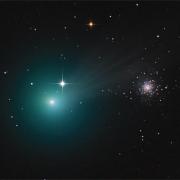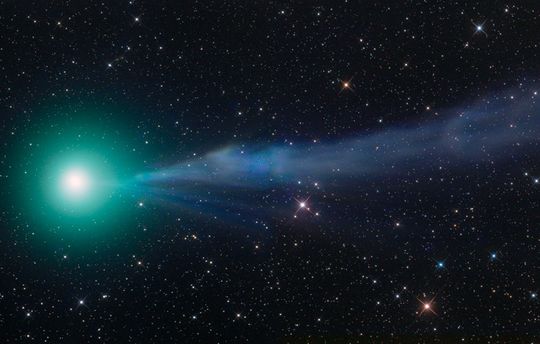
Expected Visibility
Originally expected to be a reasonable binocular object under dark skies, comet Lovejoy, C/2014 Q2, has surprised us all, becoming a naked eye object visible in the winter sky to the South.
 Now a word of caution, as of writing the comet is predicted to reach 4th magnitude during the 2nd and 3rd week of January, which means most people will still require a pair of binoculars to spot it due to light pollution. But you never know with comets, it may brighten even further. If you can escape ‘light blight’ (fortunately moonlight will be absent that period) and you can find a dark oasis, and know where to look, then it should be detectable to the unaided eye.
Now a word of caution, as of writing the comet is predicted to reach 4th magnitude during the 2nd and 3rd week of January, which means most people will still require a pair of binoculars to spot it due to light pollution. But you never know with comets, it may brighten even further. If you can escape ‘light blight’ (fortunately moonlight will be absent that period) and you can find a dark oasis, and know where to look, then it should be detectable to the unaided eye.
Remember comet L4 Panstarrs, which appeared in March and April of 2013? Forecast to be easily visible to the naked eye, L4 did not brighten as predicted and was just about written off as any kind of spectacle. So, when all seemed lost, the comet rallied and became quite reasonable. However most people failed to spot it. The weather didn’t help, neither did the comet’s location low in the western twilight sky – it was difficult when at its brightest.
Assuming it continues to brighten, Comet Lovejoy on the other hand will be visible high to the South for a good part of the night, allowing ample time for it to be tracked down, observed and imaged.
Comet History
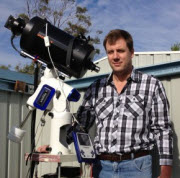
Terry Lovejoy with his
Celestron 8 cope in Brisbaine
Comet Lovejoy was discovered by Australian amateur Terry Lovejoy, last August.
C/2014 Q2 turned out to be a very long-period comet, but this is not its first pass through the inner solar system. On the way in, its path showed an orbital period of roughly 11,500 years, but slight perturbations by various planets during this apparition will alter the orbit slightly, so that it will next return in about 8,000 years.
Appearance
In images the comet appears green, the glow coming from molecules of diatomic carbon (C2) fluorescing in ultraviolet sunlight in the vacuum of space.
By contrast, the comet's ion tail (gas tail) is much narrower and points directly away from the Sun, and is tinted blue. The ion tail's colour comes from fluorescing carbon monoxide ions (CO+). If comet Lovejoy had been producing more dust (as really memorable great comets do) it would have appeared whiter in hue, the dust particles simply reflecting sunlight.
How to find Comet Lovejoy
Wait until after Jan 7th when moonlight is waning. On that day the comet will pass closest to Earth: at a distance of 0.47au (44 million miles/70 million km); and the comet will be in Northernmost Eridanus, west of Orion. As the comet reaches its brightest, this coincides with the favourable ‘dark sky window’ of opportunity, by which time the comet is crossing through Taurus and Aries high in the early evening sky. It then passes 8° West-Southwest of the Pleiades on the evening of January 17th.
The comet doesn't reach perihelion until January 30th, at a rather distant 1.29 a.u. from the Sun. By that date the comet should finally be starting to fade slightly from Earth's point of view, and by late January the Moon returns.
On the charts the position of the comet is marked every 2 days [mm/dd magnitude]. Magnitude estimates may be 1-1.5 magnitudes brighter (lower) than indicated.
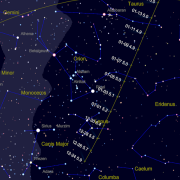 |
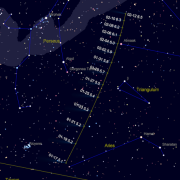 |
| Climbing past Orion up to 17-Jan-2015 |
Climbing past Perseus |
If conditions are favourable we shall endeavour to image the comet using the Cook refractor. At very least it should be apparent as fuzzy grey blob.
Image Credits
- Comet C/2014Q Lovejoy (top image): unknown
- Comet Lovejoy+M79 Galaxy: Chris Schur of Arizona
- Finder charts: Created using Cartes du Ceil (Sky Charts) from Bob Moler's blog
- Log in to post comments

